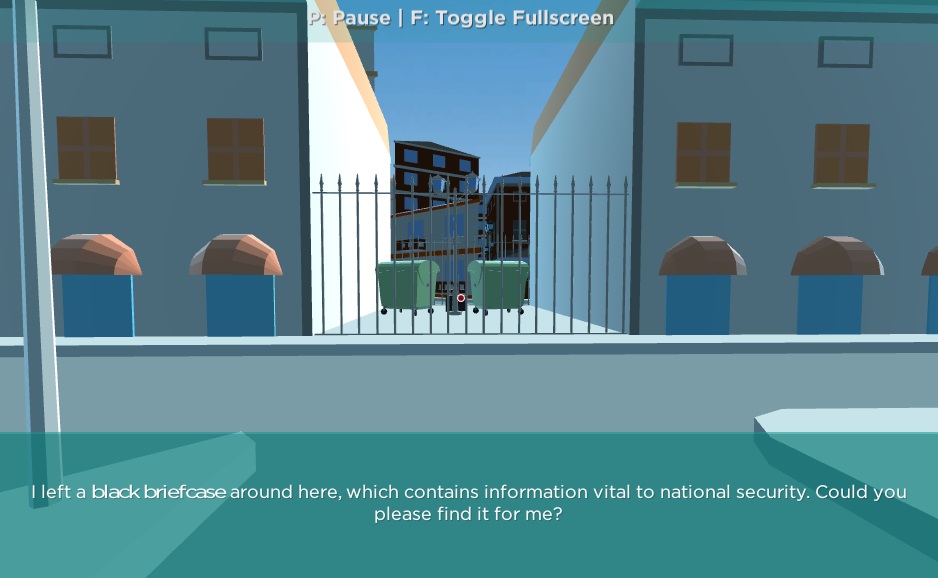Description
Example images from Scanning missions are shown below. A written description of a mission now follows.
There were 5 Scanning tests ('missions') in the Navigation battery. Each mission had the same rules and followed the same pattern of activity. Each mission comprised a single task. Twins were allowed up to four attempts to succeed in responding correctly in each mission.
Each mission involved locating and clicking on a target object, depicted as a black briefcase hidden somewhere nearby in the virtual world. The briefcase was generally located at ground level. According to the difficulty of the mission, the briefcase might be more or less obscured from view, and at different distances from the viewpoint location. During the mission, within the virtual world, the location of the respondent could not be moved (forward or back or from side to side at street level). However the view could be rotated left or right through 360 degrees (by moving the mouse from side to side) and could be moved up and down (by moving the mouse forwards or backwards).
Each attempt consisted of a mouse click on a location indicated by a red dot in the centre of the screen. Up to four clicks (attempts) were allowed within the time limit of the mission. If an attempt was correct, such that the red dot was correctly positioned over the image of the briefcase when clicked, then the mission ended and any remaining attempts were not used. If an attempt was incorrect, then either the next attempt or the next mission would follow.
Each Scanning mission had a time limit of 60 seconds for completion. Within this 60 seconds, there was no time limit on individual attempts in the mission. If the time limit expired before all the attempts had been made, then all remaining attempts were discontinued, the mission would come to an end, and the next mission in the battery would begin. There was no progress bar or timer on screen to help twins keep track of time; however, "hurry up" prompts appeared on screen as the time limit approached.
Feedback was provided after each attempt in order to encourage a twin to keep trying to complete the mission. There were normally only two possible outcomes in each attempt: either it was completed successfully (click on target) or it was failed (click off target). In either case, feedback was provided using text on screen. Success in the attempt, and hence in the mission, was shown by a message such as "Good job!". After a failed attempt, the text was highlighted with an orange background, and included a reminder of what to search for, e.g. "That doesn't seem right, remember you are looking for a black briefcase." As mentioned above, an approaching timeout was signalled by "hurry up" messages flashing on the screen; a failure due to timeout was implied by the mission ending without success, and the next mission beginning.
Input in this type of mission consisted simply of mouse movements and mouse clicks. As explained above, mouse movements were used to change the direction of view, and to try to place the red dot over the position of the black briefcase. A mouse click was used to complete each attempt to confirm the position. If a twin did not make any mouse clicks during the 60 second time limit of the mission, then the mission would time out without any meaningful response data being recorded. However, an absence of such input did not necessarily mean that the mission had been left unattended - it was possible for a twin to spend the entire 60 seconds moving the mouse around, looking for the briefcase but not finding it, and not making any clicks. For this reason, there was no "auto-pause" feature in Scanning missions; if the entire mission passed without mouse clicks, then the next mission would simply begin.
In Scanning missions, neither the compass nor the map appeared on screen.
As in all other Navigation missions, twins could pause at any stage by pressing P on the keyboard; this would stop the clock and blank out the image of the streets. A further click on P would then resume the mission.
Images of the 5 Scanning missions, depicting the position of the black briefcase in each mission, are shown in the Table of Test Items below. Example images from missions are shown under the next heading.
Example Images
The images below are screen shots taken from Scanning missions. These images serve as examples of how missions were attempted, with or without success.
The first image, below, is taken from the start of a Scanning mission. As in all Scanning missions, the initial instruction text provides a reminder of the overall aim: 'Someone left a black briefcase ... Can you help us find it?'. This text remained on screen until the first attempt was made, but did not reappear for subsequent attempts. Note that in this initial view, the black briefcase is not visible - it is necessary to rotate the direction of view in order to find it. Note also that neither compass nor map are needed in Scanning missions, so they do not appear on screen.
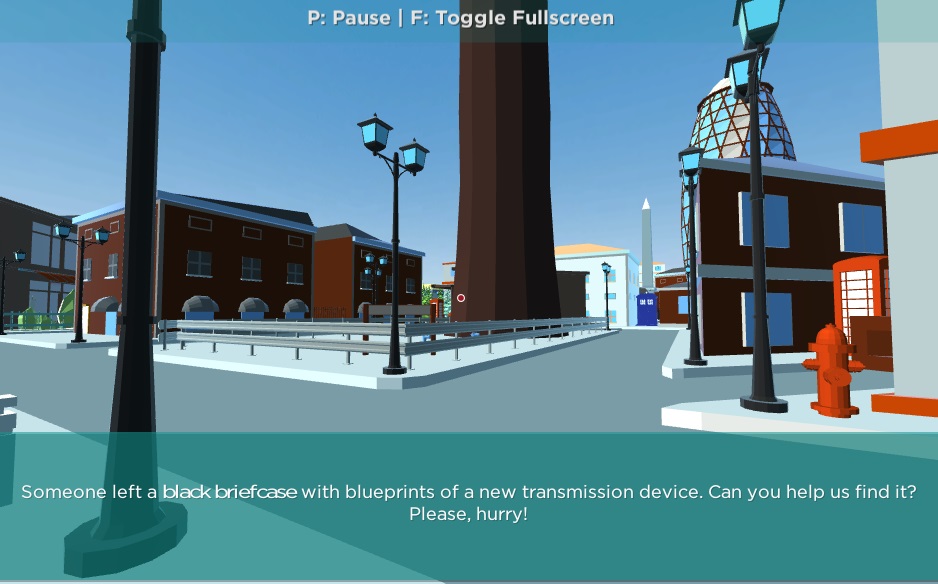
The second image, below, is taken from the 2nd or 3rd attempt of a Scanning mission - note that the instruction text has now disappeared from the screen. This image illustrates the location of the black briefcase, with the red dot positioned over it in the middle of the screen ready for a successful click.
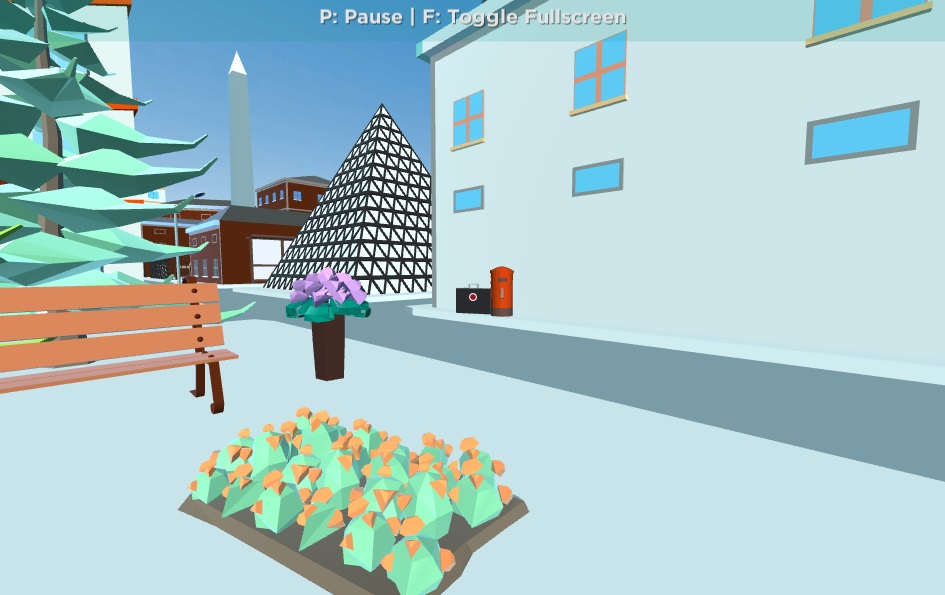
The next image (below) shows the same viewpoint immediately after success in the attempt - the feedback message ("Good job!") indicates that the mission has been completed.
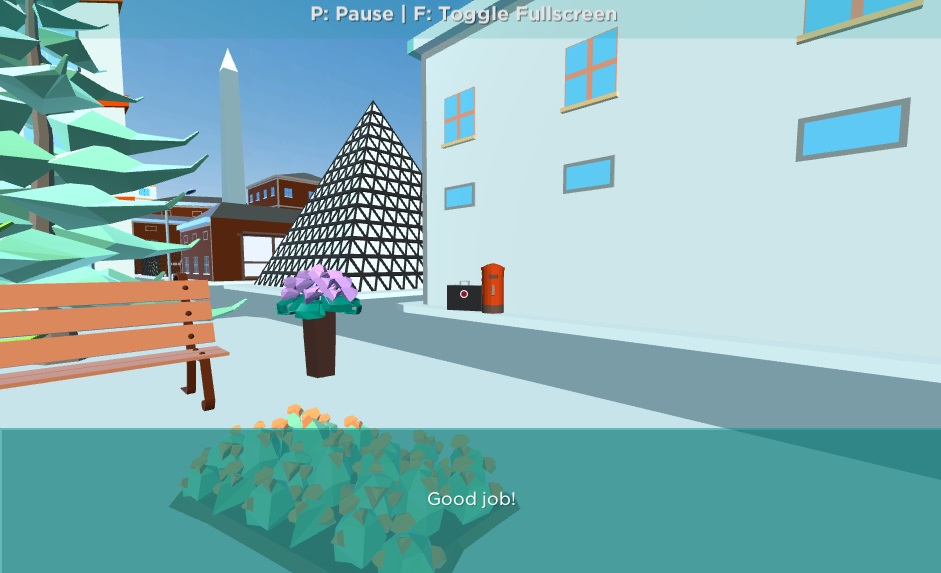
The next image, below, shows what happens after an unsuccessful attempt. A mouse-click has been made somewhere other than over the black briefcase. The feedback message, highlighted with an orange background, tells the twin that the attempt was unsuccessful and reminds them what to look for, to encourage the twin to try again with another attempt.
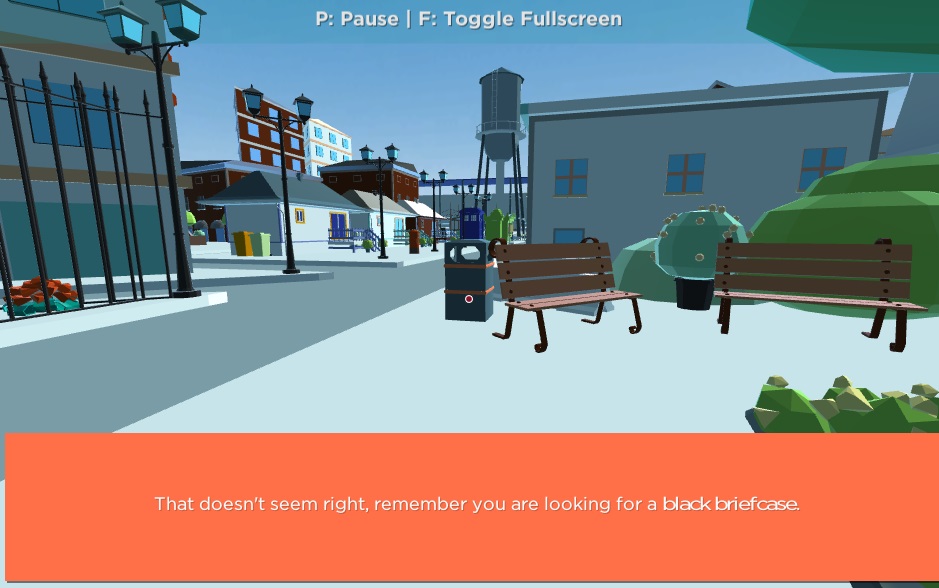
The next image (below) illustrates the "hurry up" prompt that flashed repeatedly on the screen as the 60-second mission time limit approached. If a mission timed out before it could be completed successfully, then the next mission would start without further feedback.
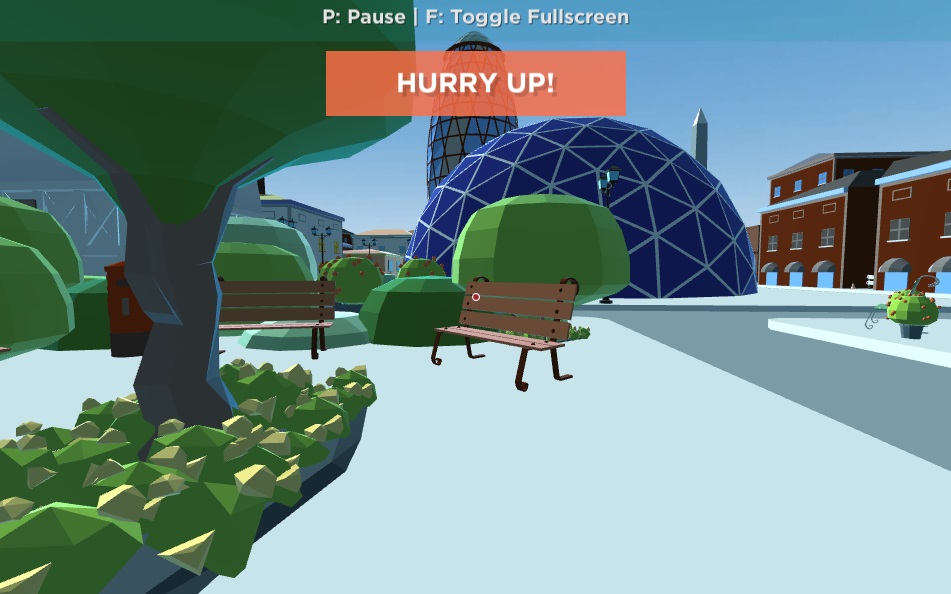
The final image (below) illustrates the "last chance" prompt that flashed repeatedly on the screen during the 4th and final attempt of a mission.
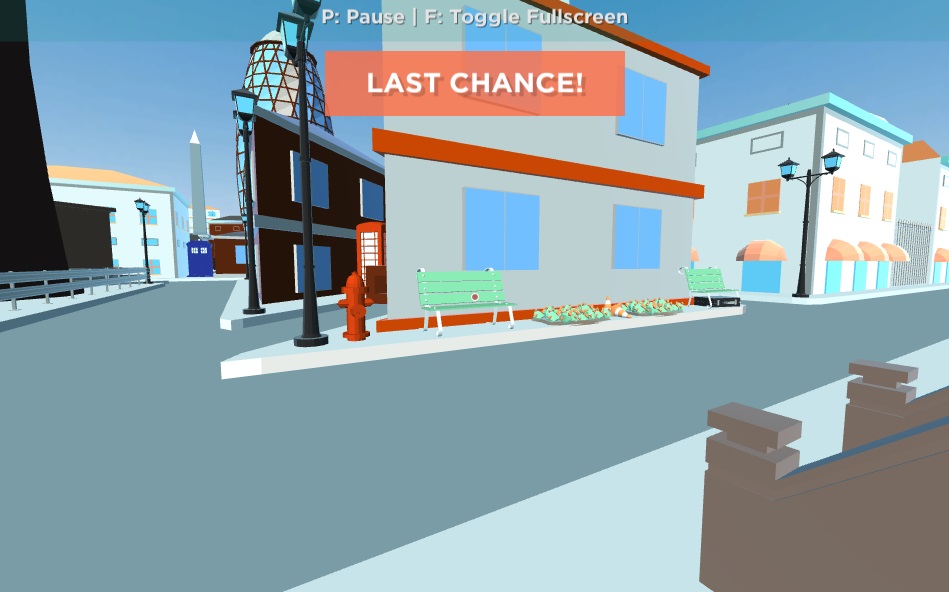
Web Test Rules
All five Scanning missions followed these rules:
- Tasks
Each mission comprised a single compulsory task. - Attempts
Up to 4 attempts were allowed to complete each mission (and hence each task). Each mission ended either on successful completion, or after 4 failed attempts, or after a mission timeout. - Timeout rule
A time limit of 60 seconds applied to each mission. As the time limit approached, text warnings would appear on screen ('hurry up') but there was no other indication of the passing of time. When the mission timed out, it would simply end and the next mission would start. - Widgets
Neither the compass nor the map appeared on screen for any tasks. - Pausing
The mission could be paused at any time by pressing P on the keyboard. The image of the virtual world was then replaced on screen by text explaining that the mission was paused, and that pressing P again would resume. Each mission could be paused indefinitely in this way, as often as a twin wished. - No auto-pausing
In the event of a mission passing without any input mouse-clicks, either because it had been left unattended or because the twin had not made an attempt, then it would time out. However, there was no auto-pause in this mission type, so the following mission would then automatically start. - Attempt outcomes
The possible outcomes for each attempt of a mission were as follows:- Success: clicked on the briefcase
- Failure: clicked elsewhere
- Attempt 2/3/4 skipped after success in an earlier attempt
- Attempt discontinued after mission timeout (could occur in during attempt 1 with no input clicks or during attempt 2/3/4 after one or more input clicks)
Dataset Item Variables
The raw item variables relating to each Scanning mission, as listed in the table below, were generated automatically by programs on the web server. For the sake of completeness, the table also lists derived variables relating directly to a Scanning mission or its component attempts. Note that the dataset only includes data for completed missions. If a twin started a mission but left it unfinished, then the data for that mission were deleted from the dataset.
Note that the raw outcome variables for each attempt (rcnscXaZcm1/2, rcnscXaZer1/2) have been dropped from the dataset in favour of a single more informative attempt outcome variable (rcnscXaZr1/2). Note also that reaction times (rcnscXaZrt1/2) have been dropped from the dataset because they are identical to the respective completion times (rcnscXaZct1/2) for Scanning attempts. The start and end dates/times have not been retained in the dataset.
In all variable names, X denotes the mission number (1 to 5) and Z denotes the attempt number (1 to 4).
| Variables | Explanation | Values |
|---|---|---|
| rcnscXdata1/2 | Mission data flag: are mission data present? [DERIVED VARIABLE] | 0=no, 1=yes |
| rcnscXstat1/2 | Mission status: was the mission completed? [DERIVED VARIABLE] | 0=not started, 1=started but not finished, 2=finished successfully, 3=compromised by loss of data, 4=compromised by random responding |
| rcnscXsttm1/2 | Start date and time of the mission [not in dataset] | Date-time values |
| rcnscXentm1/2 | End date and time of the mission [not in dataset] | Date-time values |
| rcnscXtime1/2 | Time interval from start to end of the mission [DERIVED VARIABLE] | Minutes (decimal values) |
| rcnscXdurn1/2 | Duration of actual activity during the mission | 0-60 seconds (decimal values) |
| rcnscXaZcm1/2 | Was attempt Z completed successfully? [DROPPED FROM DATASET] | 1=yes, 0=no |
| rcnscXaZer1/2 | Was an error made in attempt Z? [DROPPED FROM DATASET] | 1=yes, 0=no |
| rcnscXaZrt1/2 | Reaction time, from start of attempt to start of twin input, in attempt Z [DROPPED FROM DATASET] | Seconds (decimal values) |
| rcnscXaZct1/2 | Completion time, from start to end of attempt Z (whether completed or failed) | Seconds (decimal values) |
| rcnscXaZr1/2 | Coded outcome of attempt Z [DERIVED VARIABLE] | 1=completed successfully, 0=failed, -2=discontinued after mission timeout, -3=skipped after success in an earlier attempt, -4=no input during the entire mission |
| rcnscXas1/2 | Mission accuracy score [DERIVED VARIABLE] | 0-1 (decimal values) |
| rcnscXss1/2 | Mission speed score [DERIVED VARIABLE] | 0-1 (decimal values) |
| rcnscXts1/2 | Mission total score [DERIVED VARIABLE] | 0-1 (decimal values) |
Table of Test Items
Each Scanning mission is illustrated using an image below. Each image shows the initial instruction text given for attempt 1. Each image also shows the correct position of the briefcase, located by the red dot in the middle.
Scanning mission 1
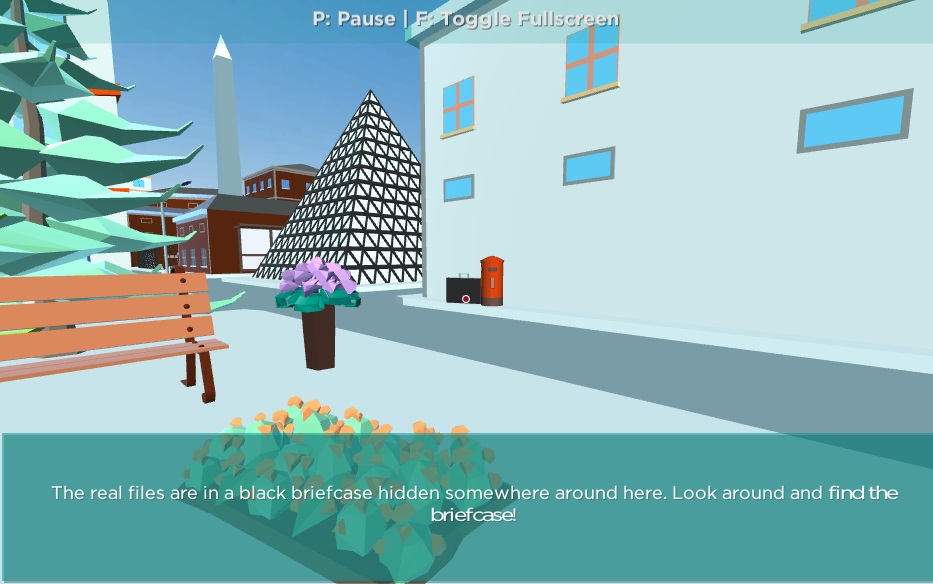
Scanning mission 2
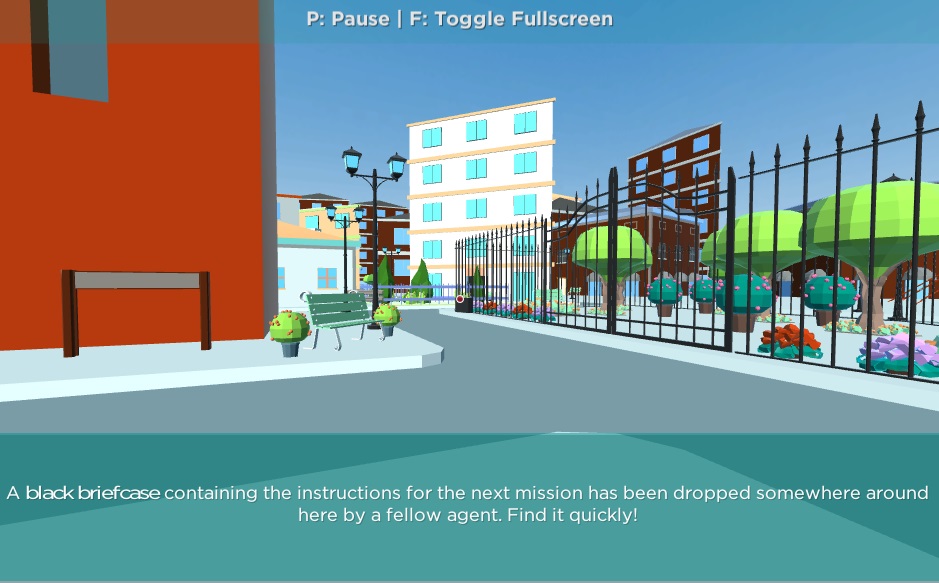
Scanning mission 3
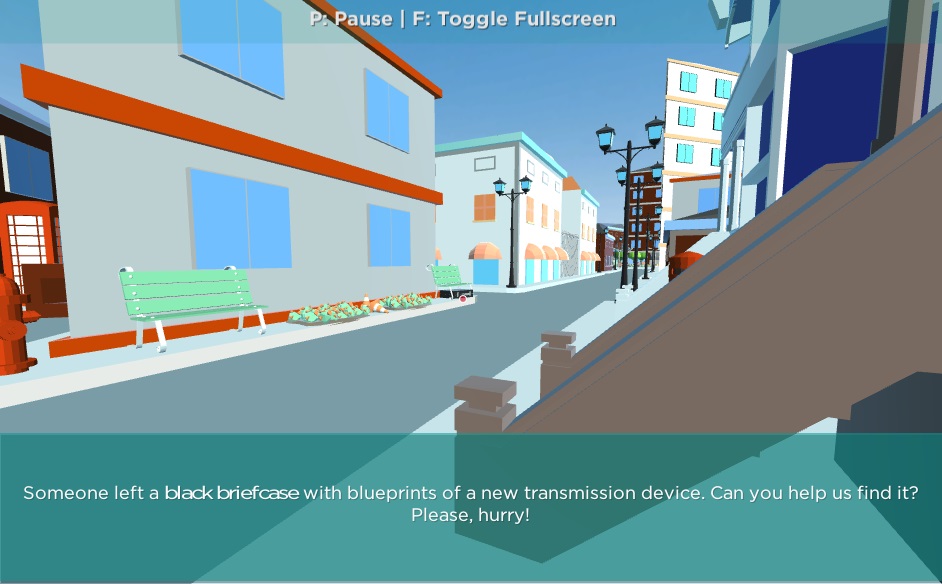
Scanning mission 4
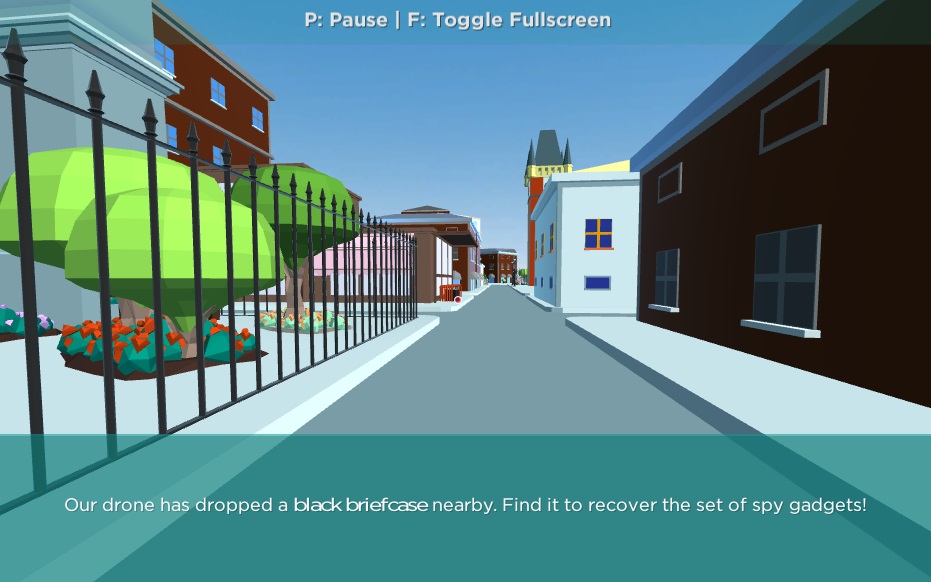
Scanning mission 5
